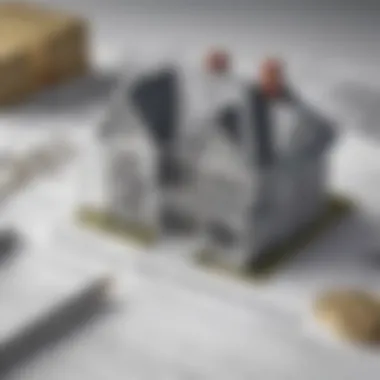Exploring Platinum Reverse Mortgages: Benefits and Considerations


Intro
Navigating the financial landscape can often feel like wandering through a maze, especially when it comes to reverse mortgages. Platinum reverse mortgages, in particular, represent a sophisticated segment of these financial products that cater to a niche demographic. This detailed exploration aims to unearth the intricacies involved in platinum reverse mortgages, shedding light on their structure, benefits, and considerations you might not find in your run-of-the-mill financial guide.
The need for financial solutions that promote wealth utilization while ensuring that homeowners maintain their quality of life has led to the rise of platinum reverse mortgages. These are typically more exclusive and may come with various unique features compared to traditional options. As we delve deeper into this topic, we will highlight key aspects such as how these mortgages function, who they are geared towards, and the potential ramifications for both borrowers and their heirs.
By the end of this discourse, you should feel better equipped to make informed decisions regarding your financial planning, particularly if you or a loved one is contemplating the suitability of a platinum reverse mortgage. Let's begin by establishing some foundational knowledge with an exploration of the essential Investment Dictionary.
Defining Platinum Reverse Mortgages
Defining platinum reverse mortgages is crucial for anyone looking to leverage their home equity without the weight of traditional loans. These financial options provide a unique blend of benefits tailored for those past retirement age, often signaling a more customizable and flexible approach to funding retirement. Understanding these mortgages can open doors for financial strategies that not only help in today’s economy but can also safeguard tomorrow’s wealth.
Overview of Reverse Mortgages
A reverse mortgage allows homeowners, typically aged 62 or older, to convert part of their home’s equity into cash. Unlike a traditional mortgage, where one makes monthly payments to a lender, with a reverse mortgage, the lender pays the homeowner. This cash can be used for various reasons—covering medical expenses, enhancing everyday living, or even traveling during retirement. The main idea is simple: homeowners can tap into the equity built up in their properties without needing to move out.
In the realm of reverse mortgages, the platinum variant stands apart. These products come with additional features and benefits that appeal to a crucial demographic—those who have significant equity and may be looking for more lucrative options.
One must consider the key components:
- Eligibility Age: Most reverse mortgages are available to homeowners age 62 and older.
- Property Type: Only certain property types are eligible, such as single-family homes, or approved multi-unit properties.
- Financial Assessment: Applicants must demonstrate they have the financial stability to cover related costs like taxes and insurance to ensure sustainability.
Essentially, platinum reverse mortgages are an opportunity for seniors to enrich their financial portfolio while staying in the comfort of their own homes.
Characteristics of Platinum Options
Platinum reverse mortgages offer unique characteristics that make them an attractive option. They often feature lower interest rates than standard options and may provide more generous borrowing limits based on the current market value of the home. However, the most compelling aspect lies in their flexible repayment plans, which can be adjusted according to the borrower’s financial situation.
Key attributes include:
- Higher Loan Limits: Compared to standard offerings, these loans often allow for larger disbursements.
- Interest Rate Options: Borrowers might choose between fixed or variable rates, depending on their risk tolerance.
- Additional Services: Some lenders provide extra services, such as financial planning advice or wealth management offerings as part of their mortgage package.
"Only the savvy recognize the layers of financial opportunity within a platinum reverse mortgage, as it’s not just about borrowing money; it’s about crafting a financial landscape tailored to one’s needs."
The Mechanism of Platinum Reverse Mortgages
Understanding the intricacies of platinum reverse mortgages requires a deep dive into their framework. This segment plays a crucial role in grasping how these financial instruments operate. By exploring their eligibility criteria, fund disbursement methods, and repayment structures, readers can get a holistic view of what sets platinum reverse mortgages apart from customary options. For many homeowners, knowing how these elements function is the cornerstone in making informed decisions about leveraging their home equity effectively.
Eligibility Requirements
To qualify for a platinum reverse mortgage, potential borrowers must meet certain criteria. First and foremost, age is a critical factor; typically, applicants need to be at least 62 years old. This age minimum ensures that the product is aimed at seniors who may want to tap into their home's equity without the burden of monthly mortgage payments.
Next, the borrower must own their home outright or have a low remaining mortgage balance that can be paid off with the reverse mortgage proceeds. This step is vital as it helps establish a base equity that the lender can rely on. Lenders will also examine the condition of the property. Homes need to be single-family residential units, and they must meet certain regulatory standards for safety and livability.
Additionally, applicants must demonstrate the financial capacity to cover property taxes, insurance, and maintenance costs. This may sound mundane, yet it's an essential piece of the puzzle; even though there are no monthly payments, homeowners must be able to handle ongoing expenses tied to their property.
"A platinum reverse mortgage can provide an avenue for financial ease, but eligibility isn’t a walk in the park."
How Funds are Disbursed
When it comes to the disbursement of funds in a platinum reverse mortgage, flexibility is a noticeable hallmark. Homeowners have options based on their financial needs and goals. They can receive their funds as a lump sum, monthly payments, or a line of credit.
- Lump Sum: This option allows immediate access to a sizable amount, which can be particularly appealing for those needing quick capital for expenses, from home renovations to medical bills.
- Monthly Payments: Borrowers can choose to take a set monthly amount for a specific duration, which can help in budgeting for regular expenses, similar to a pension.
- Line of Credit: For the homeowners who wish to keep things more fluid, a line of credit provides a safety net. It allows access to funds as needed, making it a versatile solution for unexpected costs.
Such options empower borrowers by catering to their unique situations. However, it’s important to note that taking a larger share early can deplete the remaining equity, a reality that homeowners should weigh carefully.
Repayment Structures
Repayment structures are perhaps one of the trickiest aspects of platinum reverse mortgages. They're often misinterpreted or oversimplified, leading to confusion among potential borrowers. The primary feature of a reverse mortgage is that repayment is typically deferred until specific triggering events occur. Triggering events can include the homeowner selling the property, moving out, or passing away.
Here's how it generally works:


- Full Repayment: The total amount borrowed, along with accrued interest, is due. At this time, heirs can either refinance the loan or sell the home to cover the balance.
- Non-recourse Feature: Platinum reverse mortgages usually hold a non-recourse clause. This means that if the home’s value doesn’t cover the owed amount, the homeowner or their heirs are not liable for the difference. That's a layer of risk mitigation for borrowers and their families.
- No Surprise Bills: Since there's no monthly payment during the life of the loan, there's little surprise for the homeowners as long as they meet their ongoing responsibilities.
The repayment structure is, thus, designed not only to benefit the homeowners but also to ease the eventual burden on their heirs, who might otherwise be caught off guard by a hefty debt.
Benefits of Platinum Reverse Mortgages
Platinum reverse mortgages offer significant advantages that appeal to many homeowners. Understanding these benefits is crucial for anyone contemplating this financial option. Here, we’ll explore specific elements concerning cash flow, payment structures, and overall quality of life enhancements. This knowledge helps in making informed decisions that align with personal financial goals and lifestyle needs.
Access to Cash Flow
Access to cash flow is one of the most appealing aspects of platinum reverse mortgages. Homeowners can tap into the equity built up in their homes, turning their asset into usable funds. This can serve a myriad of purposes, such as supplementing retirement income, covering unexpected medical expenses, or even funding travel plans that had been put on hold.
The funds received can be dispensed in several ways: as a lump sum, a line of credit, or monthly payouts. Each method has its unique advantages; a line of credit provides flexibility, while a lump sum could be ideal for larger expenses. For example, a retiree might want to finally take that dream trip or remodel a kitchen that hasn’t seen much love in years.
Moreover, having access to cash flow can also alleviate some of the stress associated with financial uncertainty, offering peace of mind that many may find invaluable during their golden years.
No Monthly Payments
Another significant benefit is that platinum reverse mortgages do not require monthly payments, which can significantly ease the financial burden on retirees. Instead of facing the monthly grind of conventional mortgage payments, homeowners can enjoy their retirement with one less thing to worry about on a monthly basis.
The absence of monthly payments can free up funds for other expenses. For example, instead of allocating a portion of their pension or Social Security payments toward a mortgage, retirees can redirect those funds towards enjoying hobbies or spending time with family. Homeowners only need to pay back the reverse mortgage when they sell their home, move out, or pass away. This structure often allows retirees to live within their means without the constant pressure of monthly bills.
Improved Quality of Life
Investing in a platinum reverse mortgage can lead to an improved quality of life. Homeowners can use the additional cash to enhance their living situation. This may include updating their home with modern conveniences, ensuring it is a comfortable space for the later years.
Furthermore, tapping into home equity can empower retirees to make choices that were previously out of reach. Whether it’s having the means to travel, support a grandchild’s education, or take up new hobbies, the access to those funds can be life-changing.
In sum, by efficiently employing a platinum reverse mortgage, individuals can potentially lead a more fulfilling life. Overall, these benefits paint a compelling picture for those considering this financial option as they plan for a secure and enjoyable retirement.
"The freedom to make choices that enhance one’s quality of life cannot be overstated."
Risks and Considerations
When diving into the world of platinum reverse mortgages, one must tread carefully, as there are numerous risks and considerations that deserve close examination. Understanding these intricacies helps potential borrowers make informed decisions while evaluating whether this financial product suits their unique situation. Knowing the potential pitfalls can provide a layered perspective on how this option impacts various aspects of financial planning, especially for homeowners considering their long-term strategies.
Impact on Estate Planning
A platinum reverse mortgage can cause ripples in estate planning, affecting how assets are distributed after the homeowner passes away. Homeowners usually retain ownership of their property, but they need to consider how this financial product might influence heirs. Here are a couple of points to navigate:
- Decreased Inheritance Value: If significant equity is drawn down through the reverse mortgage, the remaining inheritance for heirs may be quite diminished. This can create a rift in family dynamics when heirs expected a certain legacy.
- Involvement of Heirs: It’s crucial for homeowners to communicate their intentions with heirs before proceeding. If heirs are not well-informed, it may lead to confusion or disagreement after the homeowner's death.
This aspect underscores how planning today can safeguard family relationships tomorrow.
Potential for Decreasing Equity
Home equity is often seen as a nest egg, providing financial stability and peace of mind during retirement. However, opting for a platinum reverse mortgage can chip away at that equity over time. Consider these implications:
- Interest Accumulation: Unlike traditional loans where equity builds faster as you pay down the principal, reverse mortgages accumulate interest on the borrowed amount. This can lead to a significant reduction in available home equity, impacting future finances.
- Potential Shortfall: Should market conditions shift or property values decline, the equity might decrease further, creating a challenging situation for homeowners. This loss could limit future borrowing options or necessitate the sale of the property sooner than planned.
Homeowners need to keep their eyes peeled on this evolving situation, factoring market fluctuations as they plan their financial futures.
Market Fluctuations and Interest Rates
Another layer of complexity lies in the market itself; economic shifts can have significant implications for platinum reverse mortgages. Homeowners and potential borrowers should be cognizant of the following:
- Variable Interest Rates: Many reverse mortgages come with variable rates tied to market conditions. This means monthly obligations could balloon if rates rise, affecting cash flow and financial stability.
- Property Values: The housing market isn't static. Both downturns and upswings can create uncertainties in available equity. Homeowners need to assess how market volatility could impact the overall value of their home and the potential equity available against it.
"In the world of finance, inconsistency is the only constant—take heed of the fluctuating tides of interest rates and market conditions."
Engaging with a financial advisor can help navigate these waters; being proactive rather than reactive is crucial.


By understanding these risks and considerations, homeowners armed with knowledge can choose wisely, ensuring that their financial planning reflects both their immediate needs and long-term aspirations.
Comparative Analysis
When it comes to making astute financial decisions, comparative analysis serves as a compass for potential borrowers contemplating platinum reverse mortgages. Understanding the nuances between various mortgage products can substantially affect one's financial landscape—especially for retirees or those nearing retirement who are looking to leverage their home equity. A well-informed choice hinges on differentiating features, terms, and benefits, which this section aims to clarify.
Platinum vs. Standard Reverse Mortgages
Both platinum and standard reverse mortgages aim to ease financial burdens during retirement, yet they aren’t cut from the same cloth. Platinum options usually offer more enhanced features, making them appealing to those with significantly higher home values or who need more cash flow. These options often come with lower interest rates and better loan-to-value ratios than standard ones.
To illustrate the difference, let’s dive into some key considerations:
- Interest Rates: Platinum reverse mortgages often have fixed rates that are lower, whereas standard ones might present a variable structure, possibly leading to increased costs over time.
- Fees: The upfront costs tied to platinum mortgages can be higher, but they may save you in the long run with terms that are more favorable.
- Repayment Models: With platinum, there tends to be more flexibility in repayment terms. This might include options that allow homeowners to remain longer in their residences without immediate financial pressure, fostering a longer-lasting relationship with their asset.
- Access to Funds: Platinum reverse mortgages can offer larger sums upfront. For instance, a borrower could access more substantial equity compared to a standard option, making it a better fit for significant expenses like healthcare or home modifications.
In essence, while both options serve similar purposes, those considering a platinum reverse mortgage are best served by weighing their unique needs against the offerings of each product.
Understanding Different Products
Navigating the mortgage landscape can feel like standing at a crossroads. Each option comes with its own set of pros and cons, especially for those eyeing platinum reverse mortgages. Understanding the various products in this realm is crucial for effective financial planning.
In addition to platinum and standard reverse mortgages, several other products deserve mention. Here are a few worth considering:
- Home Equity Conversion Mortgages (HECM): This is the Federal Housing Administration's version of a reverse mortgage. These are often more commonly known and include strict guidelines that might affect eligibility and access to funds.
- Proprietary Reverse Mortgages: Offered by private lenders, these are geared towards wealthier individuals or those with homes valued above a certain threshold. They may provide higher loan amounts than HECMs but usually come with stricter qualifications.
- Single-Purpose Reverse Mortgages: These are limited to specific usages, such as home repairs or property taxes. They can be less expensive than other types but are not as flexible.
As you consider the landscape of these financial products, it’s vital to ask yourself: what fits my current and future needs? This assessment is key in forging a path toward better financial security.
Who Should Consider a Platinum Reverse Mortgage?
The idea of a platinum reverse mortgage isn't just a financial concept; it’s a lifeline for the right individuals. As financial landscapes shift, understanding who can benefit from this specialized lending product becomes paramount. The platinum option is designed for those who have significant home equity and seek flexible cash flow without the burden of monthly payments. Let's delve into the specific elements that highlight who should seriously consider this unique financial tool.
Target Demographics
When discussing the target demographics for platinum reverse mortgages, it’s essential to focus on a few key groups:
- Retirees: Many retired individuals find themselves house-rich but cash-poor. They've paid off their mortgages and can’t access that equity to support their lifestyle or healthcare needs. Platinum reverse mortgages offer a way to tap into that equity—turning the bricks and mortar of their home into cash.
- Homeowners aged 62 or older: This is a requirement for reverse mortgages, generally. It's this age group that often has the greatest equity built up, making them prime candidates for such financial options.
- Individuals with high-value properties: Owners of upscale homes may find platinum reverse mortgages particularly appealing. Apart from having substantial equity, these homeowners also typically aspire to maintain a comfortable lifestyle as they age, which can require significant financial resources.
- Those in need of financial flexibility: Whether it’s for covering medical expenses, investing, or simply enjoying retirement without financial strain, individuals looking for a financial cushion may find this product sung to their needs.
This demographic spans both financial stability and an urgent need for liquidity, making platinum reverse mortgages particularly attractive.
When to Pursue This Financial Option
Determining when to pursue a platinum reverse mortgage involves weighing several factors that can vary widely based on individual circumstances:
- Life Stage: For many, the ideal time to consider a platinum reverse mortgage is as they approach retirement. This can provide the necessary funds to enhance quality of life during the retirement years.
- Financial Goals: If homeowners are aiming to fund specific goals—be it travel, medical needs, or supporting family members—they might explore this mortgage avenue when those needs become more prominent.
- Market Conditions: Homeowners should keep an eye on the real estate market. If home values are on the rise and they anticipate needing liquidity in the future, it might be wise to secure a platinum reverse mortgage sooner rather than later.
- Health Considerations: Health-related expenses can arise unexpectedly; individuals who see themselves facing potential medical costs may want to tap into home equity ahead of time. This option might provide peace of mind during uncertain times.
"A home isn’t just a structure; it’s often a treasure trove of potential financial resources that can change lives."
By assessing personal circumstances and recognizing when the moment is right, homeowners can leverage platinum reverse mortgages to their greatest advantage.
Navigating the Application Process
The journey of obtaining a platinum reverse mortgage is not simply a matter of filling out forms and signing papers. It requires a nuanced understanding of the steps involved, the documentation required, and the significance of working closely with lenders. This section breaks down the application process into manageable parts, emphasizing its importance for prospective borrowers who seek to make informed financial decisions.
Initial Steps in Application
When contemplating a platinum reverse mortgage, the first steps often set the stage for how smoothly the process unfolds. It’s not just about showing up with your birth certificate and bank statements. Here are some fundamental steps to consider:
- Research Options: Before diving in, it’s vital to understand what platinum reverse mortgages offer compared to other options. Knowing the advantages can guide your conversation with lenders.
- Pre-Qualification: Many lenders offer a pre-qualification stage where they can gauge your eligibility based on your financial situation and income. This step often gives you clarity and sets realistic expectations.
- Seek Financial Advice: Consulting with a financial advisor can help illuminate paths you might not have considered. They can offer insights tailored to your specific circumstances.
Initiating these steps not only prepares you for the application but also demystifies the entire process, ensuring you are ready to make decisions that align with your goals.
Documentation Required


Documentation is the backbone of any application process, including for platinum reverse mortgages. You’ll be asked for a slew of papers. Having these ready can save a fair amount of time and headaches later. Here’s a list of key documents usually required:
- Proof of Identity: Government-issued ID such as a passport or a driver’s license.
- Social Security Information: Your Social Security number is vital, as it ties into financial history checks.
- Income Statements: Lenders will want recent pay stubs or social security benefit statements.
- Property Documentation: This may include the title deeds and tax statements of your home.
- Estimates of Current Debt: Understanding your financial background helps lenders get a complete picture.
Keep in mind that each lender may have specific requirements, so it’s prudent to ask directly about their checklist ahead of time. This foresight can often expedite the process and ensure nothing is left to chance.
Working with Lenders
Your relationship with lenders during the application process should be more than a transactional one; it’s a partnership. Here are some pointers on how to effectively work with them:
- Clear Communication: Ask questions if something isn’t crystal clear. When you’re in the dark, it’s easy to misstep. A good lender will be more than happy to clarify.
- Understand Fees: Get an idea about closing costs and any additional fees that might apply. This understanding could save you from unwelcome surprises later.
- Be Honest: Lenders appreciate transparency. Present your financial situation truthfully; this helps in tailoring the best possible product for your needs.
- Follow-Up Regularly: Don't hesitate to reach out for updates. Timing can be critical in financial decisions, and staying informed about your application ensures you remain in control.
"An informed borrower is an empowered borrower; the more you know, the better your decisions."
Navigating the application process for a platinum reverse mortgage can seem like a labyrinth, but with a firm grasp on the initial steps, documentation, and lender relations, you can make this methodical rather than overwhelming. Knowing what to expect and how to arm yourself with the right information lays the foundation for success in your application journey.
Exploring Alternatives
In the realm of reverse mortgages, especially when considering platinum options, it becomes essential to explore alternatives. Homeowners or their heirs may not always recognize that while platinum reverse mortgages offer unique benefits, there are other financing avenues worth investigating. Considering these alternatives allows for a dive into the intricacies of one’s financial situation. Each option comes with its particular set of characteristics, advantages, and drawbacks, which can significantly shape overall financial health.
Home Equity Loans
Home equity loans are often likened to a double-edged sword—they can provide immediate access to cash but can also incur risks if not managed correctly. A homeowner willing to tap the equity built up in their property may find this option appealing. Unlike a reverse mortgage, which doesn’t require monthly repayments until the borrower moves or passes away, a home equity loan typically requires regular payments to the lender right from the get-go. This can make it an excellent choice for those who prefer to maintain a consistent payment schedule.
Benefits of home equity loans include:
- Lower interest rates: Generally lower than personal loans or credit cards, making it a cost-effective choice.
- Lump-sum access: Provides a one-time cash inflow, which can be utilized for large expenditures.
- Ownership retention: The homeowner remains the title holder, just like with a traditional mortgage.
However, these loans come with significant considerations. Borrowers must have an adequate credit score and stable income to qualify. Furthermore, it can lead to a decrease in equity if the home’s value declines, affecting long-term financial plans.
Ultimately, home equity loans can be a solid option for homeowners looking for immediate cash flow without the complexities involved with reverse mortgages. Understanding these nuances is critical for making informed decisions tailored to personal circumstances.
Traditional Mortgages vs. Reverse Mortgages
When comparing traditional mortgages to reverse mortgages, the contrast is stark yet informative. Traditional mortgages rely on future earnings—the borrower provides regular payments in exchange for money borrowed to buy a home. In contrast, platinum reverse mortgages flip this narrative: they convert home equity into cash while postponing repayment until the homeowner decides to sell, moves, or passes away.
Here are key differences to note:
- Repayment Terms:
- Eligibility Factors:
- Impact on Estate:
- Traditional Mortgages: Monthly payments start immediately.
- Reverse Mortgages: Repayment occurs at a later time, providing a cash lifeline in retirement.
- Traditional Mortgages: Require stable income and creditworthiness.
- Reverse Mortgages: Primarily targeted towards seniors, focusing on their home equity rather than income.
- Traditional Mortgages: Mortgage debt reduces equity; the estate inherits a burden.
- Reverse Mortgages: The estate keeps the remaining equity post-repayment of the loan balance.
Most importantly, both financing options have their own merits and downsides, thus necessitating the need to analyze individual financial situations. A traditional mortgage might work well for younger homeowners, while seniors seeking supplemental income might find platinum reverse mortgages fitting their needs better.
Understanding all these alternatives is key for people navigating their financial future, particularly in preparing for retirement and planning for succession. Engaging in this deeper examination can ensure that all available resources and paths are thoroughly considered.
Culmination and Final Thoughts
Navigating the world of platinum reverse mortgages can feel like wandering through a labyrinth filled with intricate twists and potentially rewarding exits. Having explored the various facets of this financial product, it’s crucial to distill the key insights to foster understanding and facilitate informed decision-making. The significance of a thoughtful conclusion encapsulates the essence of the previous discussions, emphasizing how these unique mortgage solutions play a pivotal role in retirement planning and estate management.
Summarizing Key Points
Revisiting the highlights from our exploration:
- Understanding the Basics: Platinum reverse mortgages are not just another financial product; they represent a unique approach where homeowners use their home equity as a source of retirement income.
- Benefits are Multifaceted: From providing cash flow without the burden of monthly payments to enhancing one's living conditions, the benefits are many. This creates opportunities for enhancing quality of life, enabling retirees to pursue passions that may have been sidelined due to financial constraints.
- Risks Should Not be Ignored: It’s essential to acknowledge the potential downsides, including the impact on estate planning, the possibility of decreasing equity, and sensitivity to market fluctuations. Each of these concerns necessitates careful consideration to make sure they align with personal financial goals.
- Comparative Insights: When weighing platinum versus standard reverse mortgages, the distinctions can influence the choice significantly, tailored to specific needs and future outlooks.
- Future Potential: Understanding the evolving landscape of reverse mortgages prepares potential borrowers and financial advisors alike to anticipate and respond to future trends and shifts in the market.
In essence, a comprehensive comprehension of platinum reverse mortgages requires diligent research and proactive planning. It serves as a beacon for those nearing retirement, offering pathways to enhance financial well-being.
Future Trends in Reverse Mortgages
The future of platinum reverse mortgages looks promising yet complex. As more homeowners recognize the strategic use of home equity in financial planning, we can expect several trends to take shape:
- Technological Advancements: As technology continues to weave itself into nearly every sector, the mortgage industry is no exception. Innovations in online platforms, streamlined application processes, and tools for assessing eligibility may influence how borrowers approach these products.
- Regulatory Changes: Legislative shifts may reshape the landscape, affecting how reverse mortgages are structured and regulated. Keeping abreast of policy updates can be crucial for both lenders and potential borrowers.
- Increased Customization: Homeowners may seek more tailored solutions that reflect their unique financial situations. Lenders could respond with a wider array of product offerings that cater to diverse needs, improving accessibility for a broader audience.
- Integration with Retirement Planning: As retirement planning becomes more inclusive of various financial products, platinum reverse mortgages may feature more prominently alongside conventional retirement tools. Financial advisors may advocate for a cohesive strategy that integrates these solutions for optimal results.
- Rising Awareness: Education around reverse mortgages will likely grow, leading to more informed consumers. Outreach programs, webinars, and advocacy by financial institutions can demystify these products, equipping potential borrowers with necessary knowledge.
As these trends unfold, it becomes imperative for stakeholders to remain vigilant and adaptive. Understanding how these elements come together can produce more meaningful engagement with platinum reverse mortgages, ensuring they serve as a valuable asset in retirement planning.



